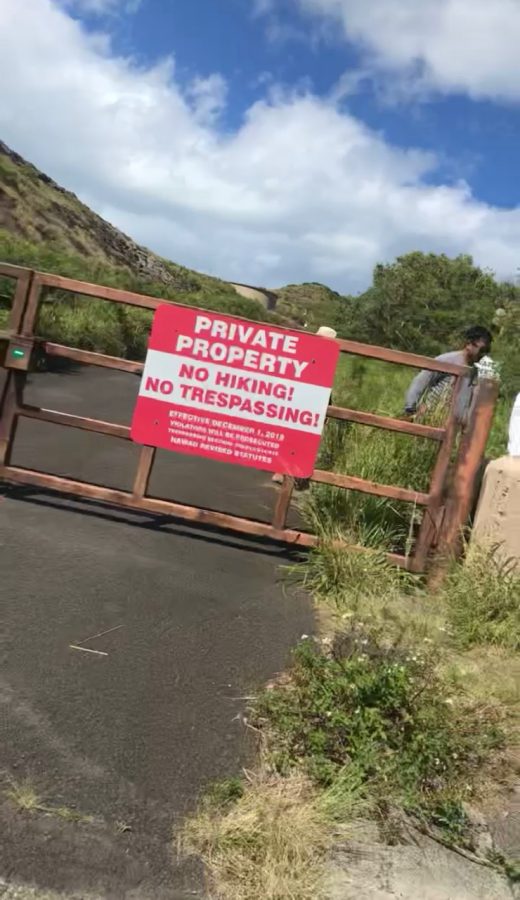Opinion: Hawaii Cracks Down Too Much on Hikes, Hikers
Adventurous hikers escaping a ticket as they return from their trip up Dead Man’s Catwalk.
In 2015, the city of Honolulu cited 328 and arrested five for trespassing the Stairway to Heaven hike. According to the City Prosecutor’s Office, criminal trespass in the second degree carries a whopping $1,000 fine.
Stairway to Heaven is a treasure of Oahu that people will continue to hike regardless of concerns of being fined. Our tax dollars are being wasted paying for police officers citing and arresting thrillseekers who wish to enjoy the sheer beauty Hawaii has to offer.
Stairway is closed because it falls on property that is maintained by the Board of Water Supply, which has deemed the hike highly dangerous. Two other hikes closed from unfortunate experiences include Sacred Falls and Mariner’s Ridge hike. Sacred Falls was closed in 1999 after 8 hikers were killed by falling rocks within the canyon according to fire department officials. Nature causes deaths all of the time; whether in the ocean or on land, we are at risk of natural disasters.
The State of Hawaii and Board of Water Supply are killjoys when it comes to Oahu’s hiking scene because when an activity outside of the water becomes slightly dangerous, they close it and then cite hikers who attempt it after its closure. Oahu is home to many beautiful hikes that are now closed and illegal either due to private property or “safety reasons.”
Dead Man’s Catwalk and Tom Tom Trail are two beautiful hikes that sit on private property (Kamehameha land). Mariner’s Ridge also sits on Kamehameha land and was closed as private property in April 2013 shortly after a 70-year-old tourist fell off the hike from a potential heart attack and died. Mariner’s Ridge and Sacred Falls are two trails that were closed for safety/private property, although they are arguably just as safe as many of the tourist favorites including Diamond Head Hike, Koko Head, and Manoa Falls. Apparently the hundreds of water-related deaths and injuries are nothing compared to those that occur when hiking.
On a busy December day on the North Shore of Oahu, Honolulu’s Ocean Safety and Lifeguard services performed 45 rescues in addition to the 4,200 preventative actions taken by lifeguards, according to a Hawaii News Now article in December 2019.
Honolulu Fire and Rescue are on call year round answering hiker distress calls, averaging a minuscule one rescue per day. Assuming the other beaches of Oahu had rescues on the same day, there were more than 45 water rescues as opposed to a mere one rescue per day made to distressed hikers.
Not only do these hikers have to worry about a citation for trespassing, but also covering their rescue fees if any emergency were to happen. The state currently allows government agencies to receive reimbursements from rogue hikers who have strayed off trail and require rescue. This alone is unfair to hikers because even when waters are deemed unsafe, the lifeguards on patrol will still rescue the same idiots who ignored the signs to go for a swim, yet they break the rules and receive rescue at no charge.
Apparently this was not enough for the state because it is now working on passing House Bill 1924, which entails that even when a hiker dies on a hike, the hiker’s estate, guardians, or custodians could be responsible to reimburse the government on behalf of the deceased hiker if he or she needed help.
The Honolulu Fire Department has urged against this because it understands that if hikers are going to have to pay rescue, they will resist calling for help, according to an interview with KHON2 News. The same logic is used by those who drive themselves to the hospital instead of taking an expensive ambulance ride. The government wastes our tax dollars on a variety of useless ideas, but making hikers reimburse them for their rescue is idiotic.
If the city were smarter, they would start by opening a legal, non-intrusive route to Stairway, and creating a system in which the maintenance of the stairs could potentially pay for itself. People are going to hike Stairway regardless of whether it is legal or illegal, so the state may as well make a non-intrusive and safer route. Closing off Hawaii’s best hiking trails solves nothing. If a hike is labeled illegal but is still accessible, we will still hike them or we will find a way to hike them.
